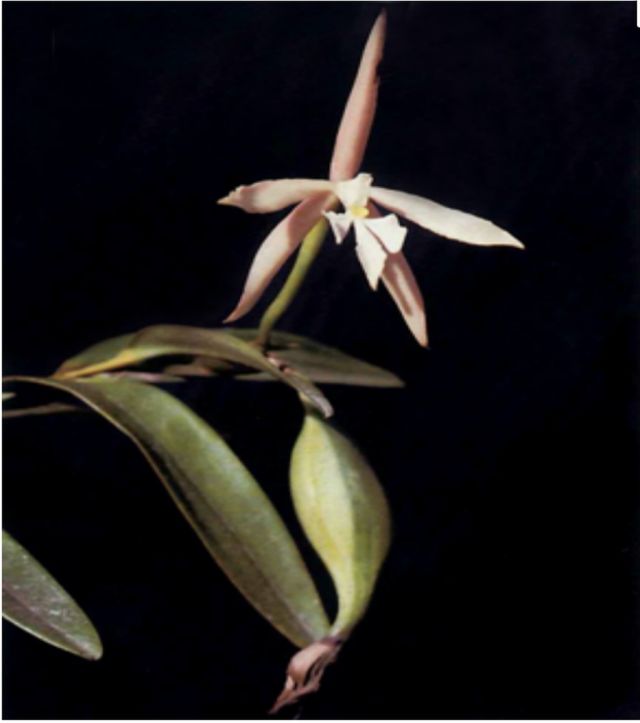

Epidendrum espiritu-santense Dodson & R.Vásquez 1989 GROUP Nocturnum SUBGROUP Nocturnum
Photo by © R Vasquez and The AMO Herbario Website
TYPE Drawing TYPE Drawing by © Dodson & Vasquez and The Swiss Orchid Foundartion at the Jany Renz Herbaria Website





Common Name or Meaning The Rio Espiritu Santo Epidendrum [Origin of the type species]
Flower Size 2" [5 cm]
Found in Cochabamba department of Bolivia in lowland forests in the Amazon basin at elevations around 200 to 560 meters as a medium sized, hot to warm growing terrestrial with basally terete, flattened towards the apex, cane-like, thin, straight stems carrying 5 to 10, all along the stem, distichous, coriaceous, oblong-elliptic, obtuse, bilobed apically leaves that blooms in the summer and fall on a terminal, arising on a mature stem, occuring only once, racemose, 2" [5 cm] long including the peduncle, successively single, few flowered inflorescence with much shorter than the ovary, embracing, triangular, acute floral bracts and carrying resupinate flowers with the sepals brown to greenish, petals, lip and column are white and the calli are yellow.
"Epidendrum espiritu-santense belongs to the GROUP Nocturnum SUBGROUP Nocturnum which is characterized by the sympodial, caespitose plants, cane-like, non-fusiform stems, successive flowers on a short, racemose or pluri-racemose inflorescence, without spathaceous bracts, and large, star-shaped flowers, with similar sepals and petals; the flowers are mostly indistinguishable in shape. The Bolivian species is recognized by the ancipitose, green sometimes wine-red in color stems with 5 to 10 green to lemon leaves distributed throughout, the leaves lanceolate-oblong, ratio length/width 4 to 5:1, 1.922" to 3" x .48 to .56" [4.8 to 7.5 x 1.2 to 1.4 cm], peduncle and rachis evident, flowers small, ovary 1.2 to 1.6" [30 to 40 mm] long, sepals .92 to 1" [23 to 25 mm] long, mid-lobe of lip trulliform, narrowly unguiculate, column .32 to .4" [8 TO 10 mm] long, clinandrium-hood with a pair of prominent teeth; body of capsule displaced to the apical half. Epidendrum nocturnum Jacq. is widely distributed from Florida to Bolivia, has terete stems, shorter leaves, 1.48 to 5.6" [3.7 to 14 cm] long, longer ovary, 2 to 2.8" [50 to 70 mm] long, about as long as the sepals which are .14 to .3" [35 to 75 mm] long, peduncle and rachis shorter, column .6 to .8" [15 to 20 mm] long, body of capsule occupying nearly the full length, centered. Epidendrum tridens Poepp. & Endl. is distributed along the base of the Andes in Ecuador, Peru and Bolivia as well as south of the Guyana Shield in Venezuela, and has 3 to 5 progressive longer leaves, 3 to 5:1, 3.4 to 6" x .8 to 2" [8.5 to 15 x 2 to 5 cm], green, sometimes wine-red in color, and has a longer ovary 2.4 to 4" [60 to 100 mm], longer than the sepals 1.6 to 2.52" [40 to 63 mm], peduncle and rachis very short; column .84 to .92" [21 to 23 mm] long; capsule centered. Epidendrum taguatingense (Brieger & Bicalho) Hágsater, Meneguzzo & L.Sánchez is endemic to Brazil, in the Brazilian states of Goiás, Minas Gerais and the Federal District, and has larger plants, 16 to 42.8" [40 to 107 cm] tall, stems with 8 to 18 green leaves, distributed along the apical 2/3, length/width ratio 4 to 6:1, 3.2 to 6.4" x .48 to 1.2" [8 to 16 x 1.2 to 3.0 cm], ovary 2.4 yo 2.8" [60 to 70 mm] long, sepals .18 to .28" [45 to 70 mm] long, mid lobe linear, column .8 to .92" [20 to 23 mm] long. Epidendrum tumuc-humaciense (Veyret) Carnevali & G. Romero along the Amazon slope of the Guyana Shield, from Colombia to the French Guyana, has 6 to 27 leaves, shorter, narrower, ratio 2 to 3:1, 1.2 to 3.68 x .48 to 1.12" [3 to 9.2 x 1.2 to 2.8 cm], distributed throughout the stems, erect, green to reddish, occasionally deep wine-red, ovary generally 3.2 to 4" [80 to 100 mm] long, longer than the sepals 1.92 to 3.24" [48 to 81 mm], peduncle and rachis to .8" [2 cm] long; body of the capsule occupying the apical half of the capsule. Florally the Bolivian species is reminiscent of Epidendrum oerstedii Rchb.f., of the GROUP Coilostylis in Central America, but that species has fusiform pseudobulbs, and the inflorescence is produced from an immature growth." Hagsater etal 2015
Synonyms
References W3 Tropicos, Kew Monocot list , IPNI ; *Icones Plantarum Tropicarum plate 220 Dodson & Vasquez 1989 drawing fide; Orchids of Bolivia Vol II Laelinae Vasquez & Ibisch 2004 drawing/photo fide; Icones Orchidacearum 15[1] Plate 1523 Hagsater & Santiago 2015 photo/drawing fide
--------------------------------------------------------------------------------------------------------------------------